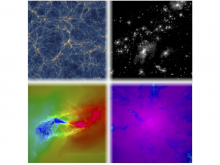
In the last decade, new observational techniques have allowed us to peer deep into the Universe’s history and glimpse galaxies which formed in the first few billion years after the Big Bang. Evidence is mounting that galaxies in the early Universe appear and behave very differently from those nearby - for example, the most massive galaxies are extremely compact, and star-forming disks appear to have strange clumpy morphologies. In this talk, I will discuss galaxy formation at these early epochs from a theoretical perspective, reviewing the physical processes that are important for producing realistic galaxies and presenting results drawn from both large-volume cosmological simulations (which allow us to compare and predict the statistical properties of galaxy populations) and high-resolution zoom-in simulations (which allow us to drill down on the physics governing individual systems). I will focus in particular on massive compact galaxies, whose varied formation and evolution present a case study on how galaxy populations evolve over time, and on massive disks, which are predicted by both simulation approaches to be very rapidly rotating in the early Universe. I will conclude by discussing some of the remaining open questions in galaxy formation and the prospects for future discoveries with upcoming facilities like JWST and WFIRST.


